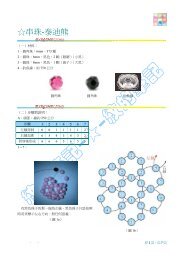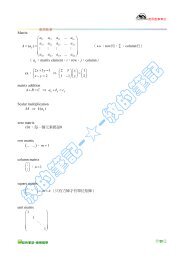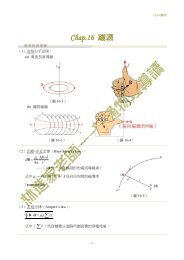Systematic scaling in the low-energy excitations of the t-J model in ...
Systematic scaling in the low-energy excitations of the t-J model in ...
Systematic scaling in the low-energy excitations of the t-J model in ...
Create successful ePaper yourself
Turn your PDF publications into a flip-book with our unique Google optimized e-Paper software.
PHYSICAL REVIEW B VOLUME 55, NUMBER 18<br />
1 MAY 1997-II<br />
<strong>Systematic</strong> <strong>scal<strong>in</strong>g</strong> <strong>in</strong> <strong>the</strong> <strong>low</strong>-<strong>energy</strong> <strong>excitations</strong> <strong>of</strong> <strong>the</strong> t-J <strong>model</strong> <strong>in</strong> one and two dimensions<br />
R. Eder<br />
Department <strong>of</strong> Applied and Solid State Physics, University <strong>of</strong> Gron<strong>in</strong>gen, Gron<strong>in</strong>gen, The Ne<strong>the</strong>rlands<br />
Y. C. Chen<br />
Department <strong>of</strong> Physics, Tung-Hai University, Taichung, Taiwan<br />
H. Q. L<strong>in</strong><br />
Department <strong>of</strong> Physics, Ch<strong>in</strong>ese University <strong>of</strong> Hong Kong, Hong Kong<br />
Y. Ohta<br />
Department <strong>of</strong> Physics, Chiba University, Chiba, Japan<br />
C. T. Shih<br />
Department <strong>of</strong> Physics, National Ts<strong>in</strong>g Hua University, Hs<strong>in</strong>chu, Taiwan<br />
T. K. Lee<br />
Department <strong>of</strong> Physics, Virg<strong>in</strong>ia Tech, Blacksburg, Virg<strong>in</strong>ia<br />
and Institute <strong>of</strong> Physics, Academia S<strong>in</strong>ica, Nankang, Taipei 11529, Taiwan<br />
Received 20 November 1996<br />
We present an exact diagonalization study <strong>of</strong> <strong>the</strong> <strong>low</strong>-<strong>energy</strong> s<strong>in</strong>glet and triplet states for both <strong>the</strong> onedimensional<br />
1D and 2D t-J <strong>model</strong>s. A scan <strong>of</strong> <strong>the</strong> parameter ratio J/t shows that for most <strong>low</strong>-<strong>energy</strong> states<br />
<strong>in</strong> both 1D and 2D <strong>the</strong> excitation <strong>energy</strong> takes <strong>the</strong> form E(t,J)a•tb•J. In 1D this is <strong>the</strong> natural consequence<br />
<strong>of</strong> <strong>the</strong> factorization <strong>of</strong> <strong>the</strong> <strong>low</strong>-<strong>energy</strong> wave functions, i.e., sp<strong>in</strong>-charge separation. Exam<strong>in</strong>ation <strong>of</strong> <strong>the</strong><br />
<strong>low</strong>-<strong>energy</strong> eigenstates <strong>in</strong> 2D shows that most <strong>of</strong> <strong>the</strong>se are collective modes, which for larger J correspond to<br />
a periodic modulation <strong>of</strong> <strong>the</strong> hole density. The modulation is well reproduced by treat<strong>in</strong>g holes as hard-core<br />
bosons with an attractive <strong>in</strong>teraction. S0163-18299713117-4<br />
Deviations from ‘‘generic’’ Fermi-liquid behavior observed<br />
<strong>in</strong> <strong>the</strong> normal state <strong>of</strong> high-temperature superconductors<br />
have <strong>in</strong>spired a search for exotic ground states <strong>of</strong><br />
strongly correlated electron systems. Thereby a twodimensional<br />
2D version <strong>of</strong> <strong>the</strong> Tomonaga-Lutt<strong>in</strong>ger liquid<br />
TLL, which is realized <strong>in</strong> various 1D systems, 1,2 has<br />
received considerable attention. In a TLL <strong>the</strong> entire <strong>low</strong><strong>energy</strong><br />
excitation spectrum consists <strong>of</strong> collective <strong>excitations</strong>,<br />
result<strong>in</strong>g <strong>in</strong> a ‘‘decay’’ <strong>of</strong> <strong>the</strong> physical electron <strong>in</strong>to pairs <strong>of</strong><br />
such collective modes and consequently ra<strong>the</strong>r unusual physics.<br />
Exact diagonalization al<strong>low</strong>s to systematically scan <strong>the</strong><br />
entire <strong>low</strong>-<strong>energy</strong> spectrum <strong>of</strong> small clusters and even to<br />
analyze <strong>the</strong> wave functions <strong>of</strong> <strong>low</strong>-<strong>energy</strong> states and thus<br />
provides a unique tool to obta<strong>in</strong> approximation-free, unbiased<br />
results for 2D strong correlation systems. While <strong>the</strong><br />
effects <strong>of</strong> <strong>the</strong> cluster size pose a serious limitation, it will be<br />
shown be<strong>low</strong> that already quite small systems suffice to<br />
clearly demonstrate, e.g., <strong>the</strong> characteristic features <strong>of</strong> <strong>the</strong><br />
TLL <strong>in</strong> 1D. This suggests to seek analogies between r<strong>in</strong>gs<br />
and planar clusters, and, as will be shown be<strong>low</strong>, 2D systems<br />
<strong>in</strong>deed show some similarity with 1D. In particular, <strong>in</strong> both<br />
cases we f<strong>in</strong>d a very regular <strong>scal<strong>in</strong>g</strong> behavior <strong>of</strong> <strong>the</strong> <strong>low</strong>est<br />
excitation energies as well as evidence for a large number <strong>of</strong><br />
<strong>low</strong>-<strong>energy</strong> collective <strong>excitations</strong>. The collective charge <strong>excitations</strong><br />
can be <strong>model</strong>ed by treat<strong>in</strong>g holes as hard-core<br />
bosons.<br />
We beg<strong>in</strong> with a discussion <strong>of</strong> 1D. Figure 1a shows <strong>the</strong><br />
dispersion <strong>of</strong> <strong>the</strong> excitation <strong>energy</strong> E i.e., <strong>the</strong> <strong>energy</strong> relative<br />
to <strong>the</strong> ground-state <strong>energy</strong> for <strong>the</strong> <strong>low</strong>ermost s<strong>in</strong>glet and<br />
triplet states <strong>of</strong> a 12-site r<strong>in</strong>g with two holes. Results for both<br />
longer and shorter r<strong>in</strong>gs down to six sites are completely<br />
consistent with <strong>the</strong>se. In <strong>the</strong> S0 sector one can identify two<br />
‘‘branches’’ <strong>of</strong> states with very different dependence on J: a<br />
first branch connected by dashed l<strong>in</strong>es resembles <strong>the</strong> <strong>low</strong>er<br />
edge <strong>of</strong> a particle-hole cont<strong>in</strong>uum, and has its <strong>low</strong>est excitation<br />
<strong>energy</strong> at 2k F5/6. The excitation <strong>energy</strong> roughly<br />
scales with J, although <strong>the</strong> energies do not really scale to<br />
zero as J→0 which however is likely to be a f<strong>in</strong>ite-size<br />
effect. A second branch connected by a full l<strong>in</strong>e comes<br />
down at 4k F2/6, and is practically <strong>in</strong>variant under a<br />
change <strong>of</strong> J, i.e., its <strong>energy</strong> scale is t. The <strong>low</strong>est triplet<br />
states closely resemble <strong>the</strong> dispersion and <strong>scal<strong>in</strong>g</strong> properties<br />
<strong>of</strong> <strong>the</strong> s<strong>in</strong>glet J branch, hav<strong>in</strong>g <strong>the</strong>ir m<strong>in</strong>imum excitation <strong>energy</strong><br />
at 2k F . The s<strong>in</strong>glet t branch and triplet J branch have<br />
been discussed by Bares and Blatter based on <strong>the</strong> Be<strong>the</strong>ansatz<br />
solution at <strong>the</strong> supersymmetric po<strong>in</strong>t, J2t; 2 <strong>the</strong><br />
near identity <strong>of</strong> <strong>the</strong> <strong>low</strong>-<strong>energy</strong> s<strong>in</strong>glet and triplet spectrum<br />
is known for <strong>the</strong> undoped 1D Heisenberg antiferromagnet,<br />
where a ‘‘s<strong>in</strong>glet replica’’ <strong>of</strong> <strong>the</strong> de Cloiseaux-Pearson mode<br />
has been discussed by Mueller et al. 3 This suggests that <strong>in</strong><br />
<strong>the</strong> language <strong>of</strong> <strong>the</strong> Ogata-Shiba wave function 1 <strong>the</strong> J<br />
branches correspond to <strong>excitations</strong> <strong>of</strong> <strong>the</strong> sp<strong>in</strong> part <strong>of</strong> <strong>the</strong><br />
wave function, <strong>the</strong> t branch to an excitation <strong>of</strong> sp<strong>in</strong>less Fermions<br />
or, equivalently, hard-core bosons.<br />
0163-1829/97/5518/123135/$10.00 55 12 313 © 1997 The American Physical Society
12 314 EDER, CHEN, LIN, OHTA, SHIH, AND LEE<br />
55<br />
FIG. 1. a Lowest excitation energies for two holes <strong>in</strong> a<br />
12-site r<strong>in</strong>g for all possible momenta and different J. The figure<br />
shows <strong>the</strong> <strong>low</strong>est or <strong>low</strong>est two states for each momentum, <strong>the</strong> l<strong>in</strong>es<br />
are a guide to <strong>the</strong> eye. b EMD for <strong>the</strong> ground state <strong>of</strong> two holes <strong>in</strong><br />
<strong>the</strong> 12-site r<strong>in</strong>g dashed l<strong>in</strong>e compared to n(q) for some excited<br />
states with given momentum k full l<strong>in</strong>es. The ratio J/t0.5.<br />
The unusual nature <strong>of</strong> <strong>the</strong> <strong>low</strong>-<strong>energy</strong> <strong>excitations</strong> can be<br />
nicely seen <strong>in</strong> <strong>the</strong> electron momentum distribution EMD,<br />
†<br />
def<strong>in</strong>ed as n(q)c q,↑cq,↑.<br />
This is shown <strong>in</strong> Fig. 1b for<br />
some <strong>of</strong> <strong>the</strong> <strong>low</strong>-<strong>energy</strong> states with Sz0. The EMD’s <strong>of</strong> <strong>the</strong><br />
excited states differ appreciably from that <strong>of</strong> <strong>the</strong> ground state<br />
only near k F , which is, <strong>in</strong> pr<strong>in</strong>ciple, what one would expect<br />
for particle-hole <strong>excitations</strong> <strong>in</strong> a Fermi liquid. The only<br />
excited states, however, where <strong>the</strong> change <strong>of</strong> n(q) would be<br />
consistent with <strong>the</strong> Fermi-liquid picture are <strong>the</strong> ones with<br />
momentum k2k F . Here <strong>the</strong> decrease <strong>of</strong> n(q) at<br />
q2/6 and <strong>the</strong> nearly equal <strong>in</strong>crease at q3/6 seem to<br />
<strong>in</strong>dicate <strong>the</strong> shift <strong>of</strong> an electron between <strong>the</strong>se two momenta,<br />
as expected for a particle-hole excitation with a momentum<br />
transfer <strong>of</strong> k F5/6. For <strong>the</strong> excited states with o<strong>the</strong>r momenta<br />
no such assignment <strong>of</strong> an electron transfer with <strong>the</strong><br />
proper momentum is possible for example <strong>the</strong> 4k F s<strong>in</strong>glet<br />
state ‘‘looks like’’ a particle-hole excitation 2/6→3/6,<br />
which however would give a wrong momentum transfer <strong>of</strong><br />
5/6 ra<strong>the</strong>r than 2/6). These results may be understood<br />
by recall<strong>in</strong>g that <strong>the</strong> <strong>low</strong>-<strong>energy</strong> excited states may be<br />
thought <strong>of</strong> 2 as particle-hole <strong>excitations</strong> <strong>of</strong> ei<strong>the</strong>r a sp<strong>in</strong>on or a<br />
holon, whereas an electron near k F corresponds to a comb<strong>in</strong>ation<br />
<strong>of</strong> <strong>low</strong>-<strong>energy</strong> sp<strong>in</strong>on-holon pairs. Chang<strong>in</strong>g <strong>the</strong> occupation<br />
numbers <strong>of</strong> sp<strong>in</strong>ons and holons <strong>the</strong>refore will <strong>in</strong> turn<br />
change <strong>the</strong> n(q) <strong>of</strong> <strong>the</strong> electrons near k F . How n(q) changes<br />
<strong>in</strong> detail, however, depends on <strong>the</strong> unknown ‘‘expansion’’<br />
<strong>of</strong> <strong>the</strong> physical electrons <strong>in</strong> terms <strong>of</strong> sp<strong>in</strong>on-holon pairs, and<br />
thus need not at all be consistent with <strong>the</strong> particle-hole picture.<br />
While <strong>the</strong> <strong>low</strong>ermost states correspond to ‘‘pure’’ <strong>excitations</strong><br />
<strong>of</strong> ei<strong>the</strong>r sp<strong>in</strong> or charge degrees <strong>of</strong> freedom, <strong>the</strong>re is no<br />
reason why <strong>the</strong>re should be no mixed <strong>excitations</strong>, where <strong>the</strong><br />
sp<strong>in</strong> and charge parts <strong>of</strong> <strong>the</strong> wave function are excited simultaneously.<br />
This is demonstrated <strong>in</strong> Fig. 2, which shows <strong>the</strong><br />
excitation energies, for a larger part <strong>of</strong> <strong>the</strong> <strong>low</strong>-<strong>energy</strong> spectrum<br />
for both two and four holes <strong>in</strong> <strong>the</strong> 12-site r<strong>in</strong>g. Some <strong>of</strong><br />
<strong>the</strong> excitation energies <strong>in</strong>dicated by full l<strong>in</strong>es have <strong>the</strong> form<br />
E(t,J)a•tb•J. This could be understood if one were<br />
to assume that for <strong>the</strong>se states both, charge and sp<strong>in</strong> degrees<br />
<strong>of</strong> freedom are excited, <strong>the</strong> former hav<strong>in</strong>g t as <strong>the</strong>ir <strong>energy</strong><br />
scale, <strong>the</strong> latter hav<strong>in</strong>g J. When two or more <strong>of</strong> <strong>the</strong> l<strong>in</strong>ear<br />
E vs J curves <strong>in</strong>tersect, <strong>the</strong>y sometimes produce pronounced<br />
hybridization gaps; we believe this is <strong>the</strong> case, e.g.,<br />
<strong>in</strong> <strong>the</strong> s<strong>in</strong>glet sector for two holes and momentum 5/6. It<br />
should be noted that states <strong>in</strong> one panel are identical <strong>in</strong> all<br />
<strong>the</strong>ir possible quantum numbers; nonvanish<strong>in</strong>g matrix elements<br />
<strong>of</strong> <strong>the</strong> Hamiltonian are <strong>the</strong>refore possible, and depend<strong>in</strong>g<br />
on <strong>the</strong> strength <strong>of</strong> <strong>the</strong>se matrix elements levels may repel<br />
each o<strong>the</strong>r appreciably. In addition, <strong>the</strong>re appear to be deviations<br />
from <strong>the</strong> ideal behavior for large J; we believe that this<br />
is due to <strong>the</strong> <strong>in</strong>creas<strong>in</strong>g tendency towards hole cluster<strong>in</strong>g,<br />
which <strong>in</strong> <strong>the</strong> <strong>the</strong>rmodynamic limit is known to lead to phase<br />
separation for J larger than J c3.5. 4 In <strong>the</strong> small clusters<br />
FIG. 2. Lowest excitation energies<br />
E for <strong>the</strong> 12-site r<strong>in</strong>g with<br />
two holes top row and four holes<br />
bottom row. Sp<strong>in</strong> and momentum<br />
quantum numbers refer to<br />
both panels <strong>of</strong> one column.
55 SYSTEMATIC SCALING IN THE LOW-ENERGY EXCITATIONS ...<br />
12 315<br />
<strong>the</strong>re is no true phase transition, but ra<strong>the</strong>r a very s<strong>low</strong> and<br />
gradual crossover to <strong>the</strong> clustered state, which may lead to a<br />
bend<strong>in</strong>g <strong>of</strong> <strong>the</strong> E vs J curves. The level cross<strong>in</strong>g at<br />
J/t4, where <strong>the</strong> four-hole s<strong>in</strong>glet state with k5/6<br />
comes down be<strong>low</strong> <strong>the</strong> ground state, most probably is also<br />
related to hole cluster<strong>in</strong>g. Summariz<strong>in</strong>g <strong>the</strong> results <strong>in</strong> 1D, <strong>the</strong><br />
energies <strong>of</strong> most <strong>of</strong> <strong>the</strong> <strong>low</strong>-ly<strong>in</strong>g eigenstates to a good approximation<br />
can be written <strong>in</strong> <strong>the</strong> form E(t,J)<br />
a•tb•J. This can be understood as a consequence <strong>of</strong> <strong>the</strong><br />
factorization <strong>of</strong> <strong>the</strong> eigenfunctions <strong>in</strong>to a sp<strong>in</strong> part and a<br />
sp<strong>in</strong>less fermion part, as established by Ogata and Shiba <strong>in</strong><br />
<strong>the</strong> limit J/t→0.<br />
Motivated by <strong>the</strong>se systematics we have performed a scan<br />
<strong>of</strong> <strong>the</strong> J/t dependence <strong>of</strong> <strong>the</strong> <strong>low</strong>ermost excitation energies <strong>in</strong><br />
2D. In 2D po<strong>in</strong>t-group symmetry presents a slight complication,<br />
<strong>in</strong> that all al<strong>low</strong>ed momenta for both <strong>the</strong> 16 and 18 sites<br />
clusters are along high-symmetry l<strong>in</strong>es; <strong>the</strong> respective eigenstates<br />
<strong>the</strong>n can be classified accord<strong>in</strong>g to <strong>the</strong>ir parity under<br />
reflection by <strong>the</strong> high-symmetry l<strong>in</strong>e. In <strong>the</strong> fol<strong>low</strong><strong>in</strong>g we<br />
have only selected those states, whose parity equals that <strong>of</strong><br />
<strong>the</strong> ground state, so that <strong>the</strong>y could, <strong>in</strong> pr<strong>in</strong>ciple, be seen <strong>in</strong><br />
<strong>the</strong> dynamical charge-correlation function DCF. Then, Fig.<br />
3 shows some representative data for <strong>the</strong> J dependence <strong>of</strong> <strong>the</strong><br />
<strong>low</strong>est s<strong>in</strong>glet and triplet excitation energies. As was <strong>the</strong> case<br />
for 1D some <strong>of</strong> <strong>the</strong> excitation energies <strong>in</strong>dicated by full<br />
l<strong>in</strong>es have <strong>the</strong> form E(t,J)a•tb•J. As <strong>in</strong> 1D <strong>the</strong>re are<br />
dense cont<strong>in</strong>ua <strong>in</strong>dicated by dashed l<strong>in</strong>es with <strong>energy</strong> scale<br />
J com<strong>in</strong>g down at small J so that <strong>the</strong> l<strong>in</strong>ear branches ‘‘get<br />
submerged.’’ For some <strong>of</strong> <strong>the</strong> states <strong>the</strong> E vs J curve has a<br />
negative curvature; we believe that this is a manifestation <strong>of</strong><br />
<strong>the</strong> stronger tendency towards hole cluster<strong>in</strong>g <strong>in</strong> 2D. Extend<strong>in</strong>g<br />
<strong>the</strong> range <strong>of</strong> J up to extreme values such as J/t10,<br />
where <strong>the</strong> <strong>energy</strong> is essentially determ<strong>in</strong>ed by <strong>the</strong> number <strong>of</strong><br />
broken bonds, <strong>the</strong> energies <strong>of</strong> <strong>the</strong>se states approach that <strong>of</strong><br />
<strong>the</strong> ground state. We <strong>the</strong>refore believe that <strong>the</strong> negative curvature<br />
is a consequence <strong>of</strong> <strong>in</strong>creas<strong>in</strong>g hole cluster<strong>in</strong>g, which<br />
<strong>in</strong> <strong>the</strong> <strong>the</strong>rmodynamic limit leads to phase separation for J<br />
greater than J c1.5. 5 S<strong>in</strong>ce this critical value is smaller <strong>in</strong><br />
2D than <strong>in</strong> 1D it seems plausible that <strong>in</strong> 2D <strong>the</strong> excitation<br />
energies are <strong>in</strong>fluenced stronger. Ano<strong>the</strong>r noteworthy po<strong>in</strong>t is<br />
that previous studies 6 <strong>in</strong>dicate that most <strong>of</strong> <strong>the</strong> states which<br />
contribute significantly <strong>in</strong> <strong>the</strong> DCF seem to be ‘‘pure t<br />
branches.’’<br />
Despite some complications <strong>the</strong> above data show an undeniable<br />
analogy between <strong>the</strong> <strong>low</strong>-<strong>energy</strong> spectra <strong>of</strong> 1D and<br />
2D. To f<strong>in</strong>d out more about <strong>the</strong> nature <strong>of</strong> <strong>the</strong> 2D eigenstates,<br />
we proceed to an analysis <strong>of</strong> <strong>the</strong>ir wave functions. We start<br />
with a discussion <strong>of</strong> <strong>the</strong> static hole density-correlation function,<br />
def<strong>in</strong>ed as<br />
gR i<br />
FIG. 3. Lowest excitation energies E for<br />
different 2D cluster sizes N and electron numbers<br />
N e <strong>in</strong> 2D. Each row corresponds to one<br />
momentum, <strong>the</strong> graphs are labeled by electron<br />
concentration N e /N and sp<strong>in</strong> S.<br />
1n i1n iR,
12 316 EDER, CHEN, LIN, OHTA, SHIH, AND LEE<br />
55<br />
FIG. 4. Hole-density correlation function g(R) for <strong>the</strong> <strong>low</strong>est<br />
S0 eigenstates with four holes/hard-core bosons and different total<br />
momentum k: a t-J <strong>model</strong>, 16 sites, b hard-core bosons, 16<br />
sites, c t-J <strong>model</strong>, 18 sites, d hard-core bosons, 18 sites. The<br />
radius <strong>of</strong> <strong>the</strong> circle at each R is proportional to <strong>the</strong> value <strong>of</strong> g(R),<br />
<strong>the</strong> ratio J/t1 for <strong>the</strong> t-J <strong>model</strong> and V/t1 for <strong>the</strong> bosons.<br />
where n i is <strong>the</strong> operator <strong>of</strong> electron density at site i. The<br />
expectation value is taken with <strong>the</strong> respective eigenstate,<br />
some representative results are given <strong>in</strong> Fig. 4. In <strong>the</strong> ground<br />
state with momentum (0,0) for J/t1, g(R) is uniform <strong>in</strong><br />
16 sites and even shows a slight decrease at small distances<br />
<strong>in</strong> 18 sites. Contrary to <strong>the</strong> fairly uniform density correlation<br />
<strong>in</strong> <strong>the</strong> ground states, <strong>the</strong> <strong>low</strong>-<strong>energy</strong> s<strong>in</strong>glet states show pronounced<br />
and systematic modulations <strong>of</strong> g(R). In particular,<br />
for momentum along (1,0) <strong>the</strong>se states seem to correspond to<br />
‘‘dynamical hole columns.’’ This is rem<strong>in</strong>iscent <strong>of</strong> <strong>the</strong> results<br />
<strong>of</strong> Prelovsek and Zotos, 7 who studied static four-po<strong>in</strong>t<br />
correlation functions and for large enough J/t found <strong>in</strong>dications<br />
<strong>of</strong> columnlike hole correlations <strong>in</strong> <strong>the</strong> ground state. Our<br />
scan <strong>of</strong> <strong>the</strong> <strong>low</strong>-<strong>energy</strong> spectrum <strong>in</strong>dicates that <strong>the</strong> respective<br />
states develop quite cont<strong>in</strong>uously down to small values <strong>of</strong><br />
J/t for example <strong>the</strong> state at k(,0) has a completely l<strong>in</strong>ear<br />
E down to J0.5; <strong>in</strong> this physical parameter regime,<br />
however, <strong>the</strong> columnlike structures become nearly unobservable.<br />
In previous studies, 8,9 <strong>the</strong> correlation <strong>of</strong> holes was<br />
found to be very similar to that <strong>of</strong> hard-core bosons. By<br />
add<strong>in</strong>g an additional nearest-neighbor attractive <strong>in</strong>teraction<br />
V between hard-core bosons, we could <strong>in</strong>deed reproduce <strong>the</strong><br />
g(R) <strong>of</strong> <strong>the</strong> excited states <strong>of</strong> <strong>the</strong> t-J <strong>model</strong> surpris<strong>in</strong>gly well,<br />
as shown <strong>in</strong> Fig. 4. We believe that this is an <strong>in</strong>dication that<br />
<strong>the</strong> columns <strong>of</strong> holes represent a soundlike excitation which<br />
ga<strong>in</strong>s additional stabilization by a residual short-range attractive<br />
<strong>in</strong>teraction between holes.<br />
FIG. 5. Difference n(q) for various <strong>low</strong>-<strong>energy</strong> states <strong>in</strong> <strong>the</strong><br />
44 cluster with four holes. For each q an open full circle <strong>in</strong>dicate<br />
a positive negative n(q), <strong>the</strong> radius <strong>of</strong> <strong>the</strong> circle is proportional<br />
to <strong>the</strong> magnitude. The ratio J/t0.5, <strong>the</strong> n(k) refer to <strong>the</strong><br />
<strong>low</strong>est s<strong>in</strong>glet top row and triplet bottom row state with momentum<br />
k.<br />
The collective nature <strong>of</strong> <strong>the</strong> <strong>low</strong>-ly<strong>in</strong>g states aga<strong>in</strong> becomes<br />
very obvious <strong>in</strong> <strong>the</strong> EMD. More precisely, we consider<br />
<strong>the</strong> difference n(q) <strong>of</strong> <strong>the</strong> EMD for an excited state<br />
m<strong>in</strong>us <strong>the</strong> EMD <strong>of</strong> <strong>the</strong> ground state; this quantity reflects <strong>the</strong><br />
redistribution <strong>of</strong> electrons <strong>in</strong> momentum space when go<strong>in</strong>g<br />
over from <strong>the</strong> ground state to <strong>the</strong> excited state. Figure 5<br />
shows n(q) for some <strong>of</strong> <strong>the</strong> <strong>low</strong>-<strong>energy</strong> states <strong>of</strong> <strong>the</strong><br />
16-site cluster. As was <strong>the</strong> case <strong>in</strong> 1D, <strong>the</strong> changes <strong>of</strong> n(q)<br />
occur predom<strong>in</strong>antly <strong>in</strong> <strong>the</strong> region <strong>of</strong> k space where <strong>the</strong> EMD<br />
<strong>of</strong> <strong>the</strong> ground state drops sharply; this region is <strong>in</strong>dicated<br />
by <strong>the</strong> dashed l<strong>in</strong>e <strong>in</strong> Fig. 5. Moreover, it is usually impossible<br />
to assign transitions <strong>of</strong> a s<strong>in</strong>gle electron which could<br />
expla<strong>in</strong> <strong>the</strong> momentum <strong>of</strong> <strong>the</strong> state. Let us, for example,<br />
consider <strong>the</strong> n(q) for <strong>the</strong> triplet state with k(/2,0).<br />
Here it might seem that an electron has been moved from<br />
,0→/2,/2. However, this is <strong>in</strong>consistent with <strong>the</strong><br />
momentum <strong>of</strong> <strong>the</strong> state, (/2,0), so that this state obviously<br />
cannot correspond to a s<strong>in</strong>gle particle-hole excitation. We<br />
have performed a similar analysis for o<strong>the</strong>r momenta and<br />
po<strong>in</strong>t-group symmetries, as well as for six holes <strong>in</strong> 16 sites<br />
for both <strong>the</strong> t-J and Hubbard <strong>model</strong>s, 12 and found consistency<br />
with <strong>the</strong> particle-hole picture only <strong>in</strong> few cases. The<br />
situation is very different at <strong>low</strong>er electron concentration,<br />
where Fermi-liquid like particle-hole transitions can be<br />
clearly identified <strong>in</strong> <strong>the</strong> EMD for all <strong>low</strong>-<strong>energy</strong> states. 10<br />
Then, summariz<strong>in</strong>g <strong>the</strong> numerical results for 2D, <strong>the</strong>re is first<br />
<strong>of</strong> all an obvious analogy with 1D. Many <strong>of</strong> <strong>the</strong> <strong>low</strong>-ly<strong>in</strong>g<br />
excitation energies have a parameter dependence <strong>of</strong> <strong>the</strong> form<br />
E(t,J)a•tb•J, which <strong>in</strong> 1D reflects <strong>the</strong> factorization<br />
<strong>of</strong> <strong>the</strong> <strong>low</strong>-ly<strong>in</strong>g eigenfunctions. As was <strong>the</strong> case <strong>in</strong> 1D most<br />
<strong>of</strong> <strong>the</strong> <strong>low</strong>-<strong>energy</strong> eigenstates <strong>in</strong> 2D seem to be collective<br />
modes, correspond<strong>in</strong>g to <strong>excitations</strong> <strong>of</strong> several different<br />
particle-hole pairs. For large enough J some <strong>of</strong> <strong>the</strong>se develop<br />
<strong>in</strong>to ‘‘dynamical hole l<strong>in</strong>es.’’ This may partly expla<strong>in</strong> <strong>the</strong><br />
analogy with 1D, <strong>in</strong> that a l<strong>in</strong>e <strong>of</strong> holes would cut <strong>the</strong> sp<strong>in</strong><br />
background <strong>in</strong>to two parts <strong>in</strong> much <strong>the</strong> same way as a s<strong>in</strong>gle<br />
hole would do for a 1D system. The <strong>low</strong>est <strong>of</strong> <strong>the</strong>se columnlike<br />
states can be fol<strong>low</strong>ed from <strong>the</strong> large-J limit down to<br />
values as small as J0.50.3, and have relatively small
55 SYSTEMATIC SCALING IN THE LOW-ENERGY EXCITATIONS ...<br />
12 317<br />
excitation energies. It should be noted that our clusters al<strong>low</strong><br />
only for density modulations that are harmonics <strong>of</strong> <strong>the</strong> cluster<br />
boundary and that f<strong>in</strong>ite-size effects most probably tend<br />
to <strong>in</strong>crease excitation energies. In an <strong>in</strong>f<strong>in</strong>ite system <strong>the</strong>se<br />
collective modes <strong>the</strong>refore may well appear at <strong>low</strong> energies<br />
and <strong>in</strong> <strong>the</strong> physical regime <strong>of</strong> parameters.<br />
As for <strong>the</strong> importance <strong>of</strong> <strong>the</strong>se collective modes for <strong>the</strong><br />
<strong>low</strong>-<strong>energy</strong> physics one could envisage different scenarios. It<br />
might be that <strong>the</strong>y simply represent an additional complication<br />
‘‘on top <strong>of</strong>’’ a simple Fermi-liquid-like state, i.e., a k<strong>in</strong>d<br />
<strong>of</strong> sound wave. A second possibility would be that, similar as<br />
<strong>in</strong> 1D, <strong>the</strong> collective modes comprise <strong>the</strong> entire <strong>low</strong>-<strong>energy</strong><br />
spectrum, lead<strong>in</strong>g to <strong>the</strong> well-known ‘‘decay’’ <strong>of</strong> <strong>the</strong> physical<br />
electron, and thus some 2D analog <strong>of</strong> <strong>the</strong> Tomonaga-<br />
Lutt<strong>in</strong>ger liquid. F<strong>in</strong>ally, if one were to assume that extremely<br />
<strong>low</strong> energetic hole column <strong>excitations</strong> persist <strong>in</strong><br />
1 M. Ogata and H. Shiba, Phys. Rev. B 41, 2326 1990.<br />
2 P.A. Bares and G. Blatter, Phys. Rev. Lett. 64, 2567 1990.<br />
3 G. Müller et al., Phys. Rev. B 24, 1429 1981.<br />
4 M. Ogata et al., Phys. Rev. Lett. 66, 2388 1991.<br />
5 W. O. Putikka et al., Phys. Rev. Lett. 68, 538 1992.<br />
6 R. Eder et al., Phys. Rev. Lett. 74, 5124 1995.<br />
some way <strong>in</strong> <strong>the</strong> physical parameter range and that <strong>the</strong>se<br />
columns’ zero-po<strong>in</strong>t fluctuations dom<strong>in</strong>ate <strong>the</strong> <strong>low</strong>-<strong>energy</strong><br />
physics, one would arrive at <strong>the</strong> ‘‘meander<strong>in</strong>g doma<strong>in</strong>-wall<br />
fluid.’’ 11 However, for any <strong>of</strong> <strong>the</strong>se scenarios, <strong>the</strong> fact that<br />
<strong>the</strong> <strong>low</strong>-<strong>energy</strong> collective charge <strong>excitations</strong> also have density<br />
correlations similar to hard-core bosons suggest a nonconventional<br />
metallic state <strong>in</strong> this system.<br />
F<strong>in</strong>ancial support <strong>of</strong> R. E. by <strong>the</strong> European community is<br />
most gratefully acknowledged. Part <strong>of</strong> <strong>the</strong> research was conducted<br />
us<strong>in</strong>g <strong>the</strong> resources <strong>of</strong> <strong>the</strong> Cornell Theory Center and<br />
National Center for High Performance Comput<strong>in</strong>g <strong>in</strong> Taiwan.<br />
This work was partially supported by <strong>the</strong> National Science<br />
Council <strong>of</strong> Republic <strong>of</strong> Ch<strong>in</strong>a, Grant Nos. NSC 86-28-<br />
11-M-007-001R and 86-2112-M-001-042T<br />
7 P. Prelovsek and X. Zotos, Phys. Rev. B 47, 5984 1993.<br />
8 M.W. Long and X. Zotos, Phys. Rev. B 48, 317 1993.<br />
9 Y.C. Chen and T.K. Lee, Z. Phys. B 95, 51994.<br />
10 R. Eder and Y. Ohta, Phys. Rev. B 51, 11 683 1995.<br />
11 J. Zaanen et al., Phys. Rev. B 53, 8671 1996.<br />
12 Y.C. Chen et al. unpublished.
















